The Be Quiet! Pure Loop 280mm AIO Cooler Review: Quiet Without Compromise
by E. Fylladitakis on October 14, 2021 9:00 AM ESTTesting Results, Maximum Fan Speed
Our maximum speed testing is performed with both the fans and the pump of the kit powered via a 12V DC source. This input voltage should have the pump and fans matching the speed ratings of the manufacturer. The Pure Wings fans rotate a tiny bit faster than their specifications suggest, with our tachometer reading 1610 RPM. There was no difference between the two fans, suggesting great quality control – at least amongst the few samples that we tested.
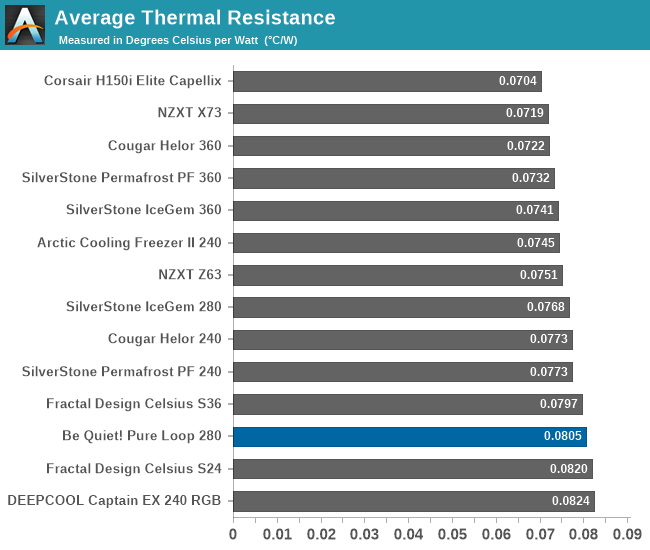
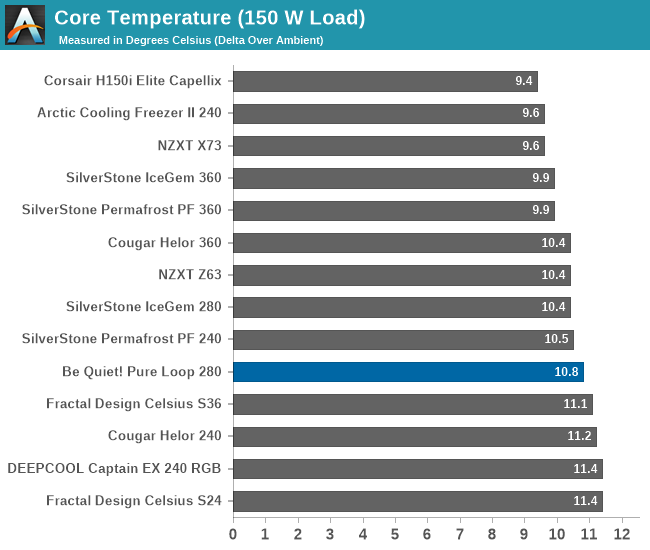
| Core Temperature, Constant Thermal Load (Max Fan Speed) |
The thermal performance charts show that the 280 mm version of the Be Quiet! Pure Loop performs on par with other similarly-sized solutions, without any significant surprises. The average thermal resistance of 0.0805 °C/W is good for a cooler with two 140 mm fans, matching the performance of most 280 mm coolers that we have tested to this date.
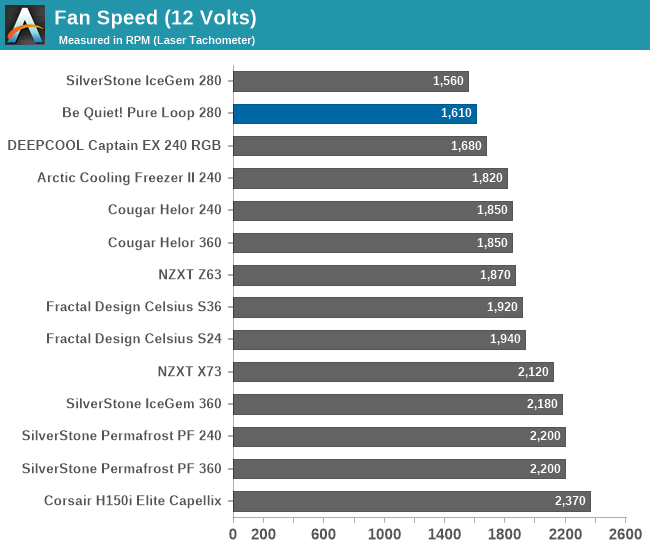
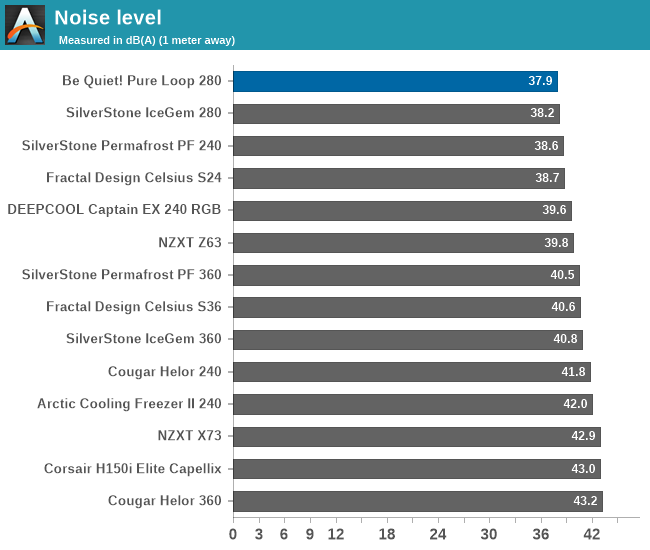
Although the Pure Loop 280 mm's thermals do not outperform most of the competition, it has a serious performance advantage comes to acoustics. With a reading of 37.9 dB(A), the 280 mm version of the Pure Loop is the quietest two-fan AIO cooler that we have ever tested. Still, 37.9 dB(A) is not an inaudible figure, so for users after especially quiet computing, they will probably not want to use their cooler at maximum speed for extended periods of time.
Testing Results, Low Fan Speed
Using a PWM voltage regulator, we reduced the speed of the fans manually down to half their rated speed, which is 800 RPM for the Pure Wings 140 mm fans. The pump was also connected to the same power source, functioning properly at this low-speed setting.
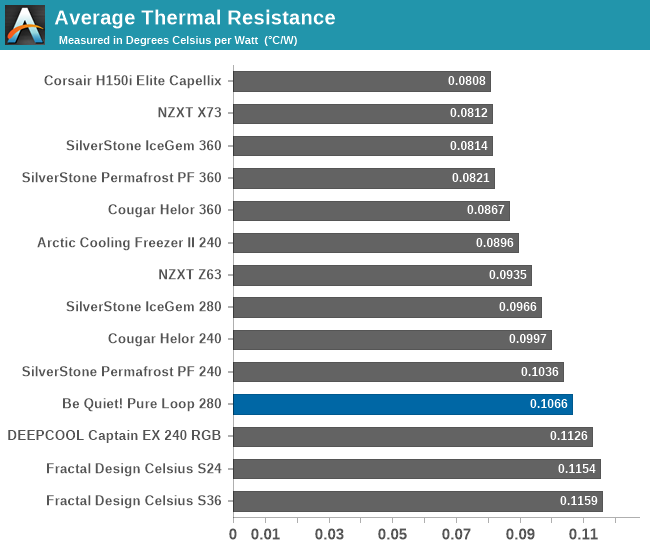
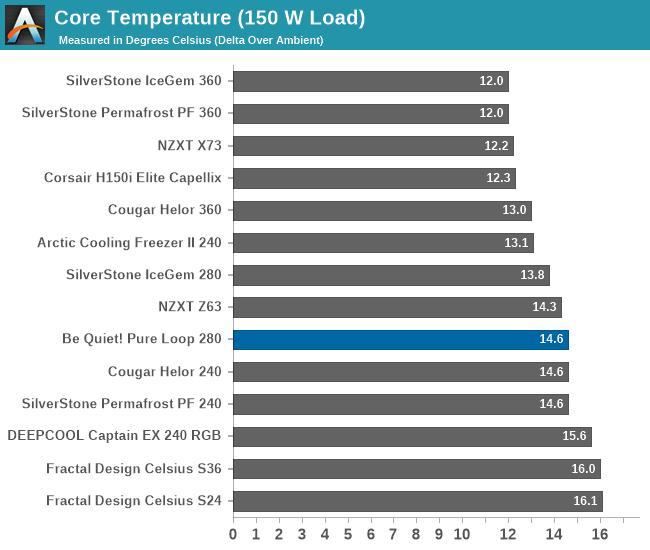
| Core Temperature, Constant Thermal Load (Low Fan Speed) |
There are no significant changes in this test, with the Be Quiet! Pure Loop offering thermal performance analogous to that of other similar AIO coolers. It falls a little behind only when the load is very high, which harms the average thermal performance of the cooler a little, resulting in an average thermal permittance of 0.1066 °C/W. However, a closer look at the charts reveals that the Pure Loop performs admirably well when the thermal load is below 150 Watts under these operating conditions.
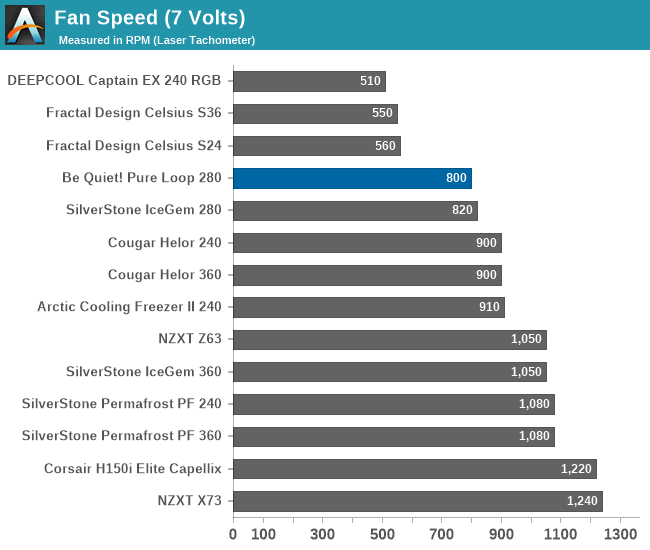
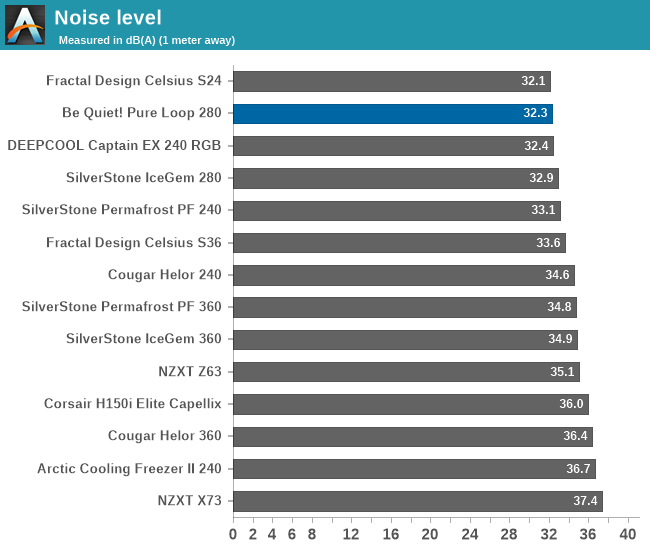
Much like before, the amount of noise coming off of the Be Quiet! Pure Loop is exceptionally low. With a noise output of 32.3 dB(A), the 280 mm version of the Pure Loop lands a better acoustic performance than that of most AIO coolers – even those with a single cooling fan. Even in the quiet October night, it is nearly dead silent under these operating conditions, audible only when someone gets very close to the cooler and in a completely quiet room.
Thermal Resistance VS Sound Pressure Level
During our thermal resistance vs. sound pressure level test, we maintain a steady 100W thermal load and assess the overall performance of the coolers by taking multiple temperature and sound pressure level readings within the operating range of the stock cooling fans. The result is a graph that depicts the absolute thermal resistance of the cooler in comparison to the noise generated. For both the sound pressure level and absolute thermal resistance readings, lower figures are better.
The graph reveals that the overall performance of the Be Quiet! Pure Loop 280 mm cooler falls between that of other similarly sized coolers. It generally is a little worse than the SilverStone Icegem 280 but a little better than the NZXT Z63 – a major win for Be Quiet!, considering the retail price of their cooler. However, from the graph, we can also see that the Be Quiet! Pure Loop 280 cannot reach very low thermal resistance figures regardless of its operating conditions, suggesting that it might not be an ideal solution for systems that may face extremely high thermal loads, even if only temporarily.











30 Comments
View All Comments
Alistair - Thursday, October 14, 2021 - link
I didn't read any clear distinction between pump noise and fan noise. Is the pump especially nice sounding or quiet also? Or just the fans run slower than the Corsair one, if so, Corsair is still a great option as long as the Corsair pump is quiet.Tom Sunday - Thursday, October 14, 2021 - link
Be Quiet is a fine company out of the Hamburg area in North Germany. Great to see the Germans now producing more high-quality goods for sale in the U.S and in the PC hobbyist world. I would most certainly buy from 'be-quiet' first and not Corsair who is satisfying their investors with mostly cheaper China goods all to making a bigger buck and over-marketing their products. As to cooling, the AIO market has always been way overpriced and much overrated; their pumps have never been perfected after all this time. And do I really care if my PC runs 10 degrees hotter? My Noctua D15 has been with me now for 10-years and straddled three completely new system builds. No downtime. I am now ready for Alder Lake with a Z690 Asus Hero MB, DDR5 and stuffed into a EATX. No doubt the 'be quiet' Dark Rock TF2 is on the bill and in 2022 my first cooler replacement in 11-years. Greetings from Stehekin, WA where you have to make things count!Oxford Guy - Friday, October 15, 2021 - link
My Corsair H50 exploded, destroying a video card and making a huge mess. Somehow the motherboard survived.COtech - Sunday, October 24, 2021 - link
These Be Quiet coolers are made in China just like the Corsair ones.Purpose - Friday, October 15, 2021 - link
This is a U-Flow radiator, not cross flow.docbones - Friday, October 15, 2021 - link
Would love to see how it compares to the Ice Giant. (for noise and cooling)SuperMover - Saturday, October 16, 2021 - link
Super Mover provides delivery services for all types of goods, products, appliances for homes and offices in Dubai Get the lowest prices on a single day delivery. Make your shipment with us today.https://www.supermovers.ae/
Jasonovich - Monday, October 18, 2021 - link
Be Quiet! Pure Loop 280 cooler looks aesthetically pleasing but where's the RGB. Not asking disco but customised cases have to look good looking into the window.Off the subject, Noctua the pinnacle manufacturers of coolers, why don't they do AIO?
ltkAlpha - Tuesday, October 19, 2021 - link
A must-have feature that I'm looking for in AIOs is the ability to link fan speed to water temperature, as you don't need to hear the fans spin up over every load spike - they do so very gradually with load. I would go so far as to say that with AIOs, for the vast majority of people, that's the key differentiating feature of water cooling. Unfortunately most reviewers completely ignore the presence of the feature (curiously, many of the brands don't actively market the feature either), so benchmark results end up being of limited usefulness to me, since a) I don't care how an AIO sounds @100% fan speed - I want to know how loud they are when temperatures stabilize at a given CPU wattage and b) I don't care about half of the products presented, so to me the comparisons are apples to oranges.Keljian - Saturday, December 4, 2021 - link
There are two brands that I know of that have this feature, Corsair and nxzt. Interestingly though the fluctuation in temperature of coolant (the band of high/low) is not big, maybe 20C or so.I actually have a thermal probe on the top fin of my D15 and the max temp when the cpu is going ballistic is about 35C or so at 20C ambient. The cpu (overclocked) however is up around 80C. I have found that having the fan ramp up for more airflow doesn’t actually make a huge difference to the temp either, some airflow is good, but it caps out pretty quickly.